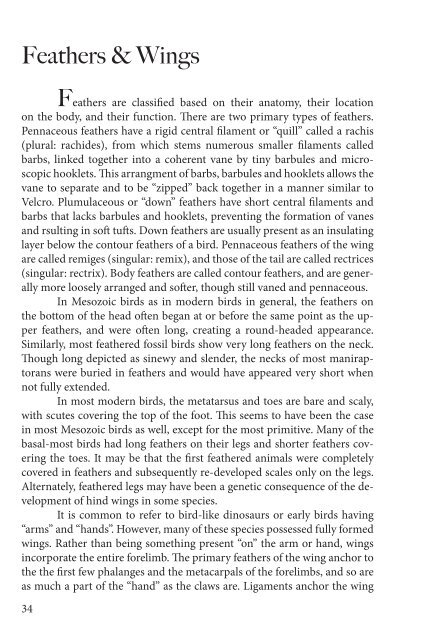Create successful ePaper yourself
Turn your PDF publications into a flip-book with our unique Google optimized e-Paper software.
Feathers & Wings<br />
Feathers are classified based on their ana<strong>to</strong>my, their location<br />
on the body, <strong>and</strong> their function. There are two primary types of feathers.<br />
Pennaceous feathers have a rigid central filament or “quill” called a rachis<br />
(plural: rachides), from which stems numerous smaller filaments called<br />
barbs, linked <strong>to</strong>gether in<strong>to</strong> a coherent vane by tiny barbules <strong>and</strong> microscopic<br />
hooklets. This arrangment of barbs, barbules <strong>and</strong> hooklets allows the<br />
vane <strong>to</strong> separate <strong>and</strong> <strong>to</strong> be “zipped” back <strong>to</strong>gether in a manner similar <strong>to</strong><br />
Velcro. Plumulaceous or “down” feathers have short central filaments <strong>and</strong><br />
barbs that lacks barbules <strong>and</strong> hooklets, preventing the formation of vanes<br />
<strong>and</strong> rsulting in soft tufts. Down feathers are usually present as an insulating<br />
layer below the con<strong>to</strong>ur feathers of a bird. Pennaceous feathers of the wing<br />
are called remiges (singular: remix), <strong>and</strong> those of the tail are called rectrices<br />
(singular: rectrix). Body feathers are called con<strong>to</strong>ur feathers, <strong>and</strong> are generally<br />
more loosely arranged <strong>and</strong> softer, though still vaned <strong>and</strong> pennaceous.<br />
In Mesozoic <strong>birds</strong> as in modern <strong>birds</strong> in general, the feathers on<br />
the bot<strong>to</strong>m of the head often began at or before the same point as the upper<br />
feathers, <strong>and</strong> were often long, creating a round-headed appearance.<br />
Similarly, most feathered fossil <strong>birds</strong> show very long feathers on the neck.<br />
Though long depicted as sinewy <strong>and</strong> slender, the necks of most manirap<strong>to</strong>rans<br />
were buried in feathers <strong>and</strong> would have appeared very short when<br />
not fully extended.<br />
In most modern <strong>birds</strong>, the metatarsus <strong>and</strong> <strong>to</strong>es are bare <strong>and</strong> scaly,<br />
with scutes covering the <strong>to</strong>p of the foot. This seems <strong>to</strong> have been the case<br />
in most Mesozoic <strong>birds</strong> as well, except for the most primitive. Many of the<br />
basal-most <strong>birds</strong> had long feathers on their legs <strong>and</strong> shorter feathers covering<br />
the <strong>to</strong>es. It may be that the first feathered animals were completely<br />
covered in feathers <strong>and</strong> subsequently re-developed scales only on the legs.<br />
Alternately, feathered legs may have been a genetic consequence of the development<br />
of hind wings in some species.<br />
It is common <strong>to</strong> refer <strong>to</strong> bird-like <strong>dinosaurs</strong> or early <strong>birds</strong> having<br />
“arms” <strong>and</strong> “h<strong>and</strong>s”. However, many of these species possessed fully formed<br />
wings. Rather than being something present “on” the arm or h<strong>and</strong>, wings<br />
incorporate the entire forelimb. The primary feathers of the wing anchor <strong>to</strong><br />
the the first few phalanges <strong>and</strong> the metacarpals of the forelimbs, <strong>and</strong> so are<br />
as much a part of the “h<strong>and</strong>” as the claws are. Ligaments anchor the wing<br />
34



